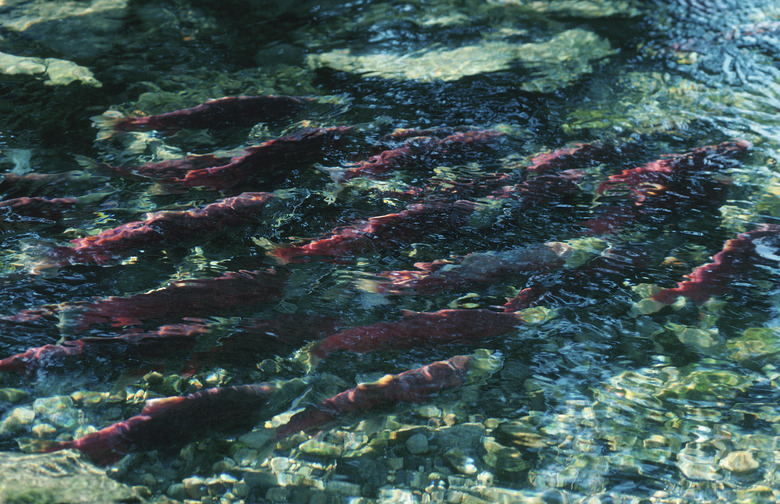Why Do Salmon & Other Fish Swim Upstream?
Salmon and other fish swim upstream because it is part of their reproductive life cycle. Salmon are born in freshwater rivers, spend most of their lives in the ocean and then return to the place they were born to lay their own eggs. Salmon swimming upstream is both a form of migration and a way to ensure that their young survive long enough to hatch and grow into adults. The journey is challenging but leads to the successful salmon populations that animals and humans depend on for food.
Salmon Reproduction
Salmon Reproduction
The main reason salmon swim upstream is to ensure the survival of their offspring. This fish spawning habit is what leads to the salmon passing down their genes successfully. Salmon are anadromous, which means they are born in fresh water, migrate to the saltwater ocean for most of their adult life and then return to fresh water to reproduce, or spawn.
As young salmon hatch in their home stream, they learn the smell of it. As they migrate downstream and into the ocean they may even memorize certain scents along the way. Even after being away for many years, when these salmon return to their birthplace as adults, they will use those smells to "test the waters" and find their home stream. If they swim up the wrong river, the familiar scent will fade and they will head back down to test another stream.
Survival of Young
Survival of Young
To prepare for spawning, the female salmon will create a depression in the riverbed using her tail. The depression is called a redd. She lays her eggs in the depression, and the male deposits milt, or sperm, on the eggs to fertilize them. The female salmon then covers the redd with gravel before moving on to create a new one. A single female salmon can lay between 2,500 and 7,000 eggs and create up to seven redds.
Though salmon species live anywhere from two to eight years, most die within days or weeks of reproducing. These fish become an important source of food and nutrients to the ecosystem and can even help plants grow. After bears or birds feed on salmon in the forest in Alaska, their carcasses are left behind. They release nutrients into the soil that nourish the Sitka spruce and hemlock trees.
Salmon Migration
Salmon Migration
Some studies have shown that salmon use the Earth's magnetic field to guide their migration. This helps them travel long distances and understand where they are going. The intensity and the inclination of the Earth's magnetic field helps the salmon orient themselves. This is a trait that is genetically inherited by salmon, which means they don't need to learn it from other fish. Many of the salmon that spawn in Seattle come from Alaska, but some travel from as far away as Japan. Some Atlantic salmon may even swim 200 miles up the river to find their preferred places to spawn.
What Kinds of Fish Swim Upstream to Spawn?
What Kinds of Fish Swim Upstream to Spawn?
There is more than one type of anadromous fish in the world. Both Atlantic and Pacific salmon swim upstream to spawn, though there are some differences between these types of fish. There are five species of Pacific salmon and only one species of Atlantic salmon. Pacific salmon include the chinook, chum, coho, pink and sockeye salmon. Some Atlantic salmon are able to spawn in fresh water, return to the ocean and then make the journey back upstream to spawn again.
Other types of anadromous fish include the steelhead, which can spawn more than once, and bull trout. Bull trout are unique because some individuals will stay in the river for their entire lives, while others will migrate to the ocean and return to the freshwater streams to spawn like the salmon.
Cite This Article
MLA
Taylor, Lindsey. "Why Do Salmon & Other Fish Swim Upstream?" sciencing.com, https://www.sciencing.com/do-other-fish-swim-upstream-8706847/. 30 September 2021.
APA
Taylor, Lindsey. (2021, September 30). Why Do Salmon & Other Fish Swim Upstream?. sciencing.com. Retrieved from https://www.sciencing.com/do-other-fish-swim-upstream-8706847/
Chicago
Taylor, Lindsey. Why Do Salmon & Other Fish Swim Upstream? last modified March 24, 2022. https://www.sciencing.com/do-other-fish-swim-upstream-8706847/
